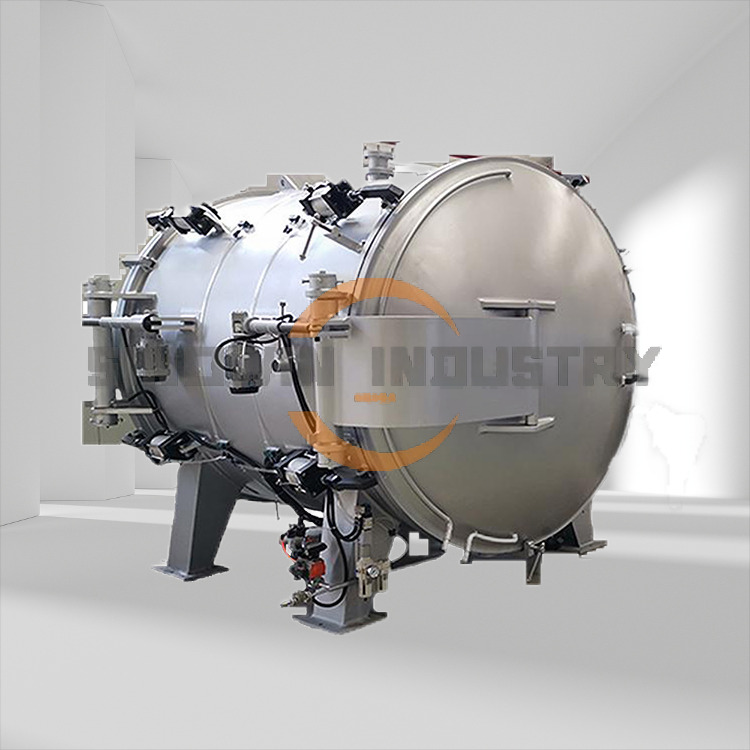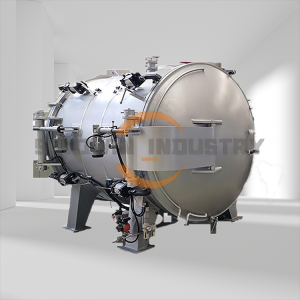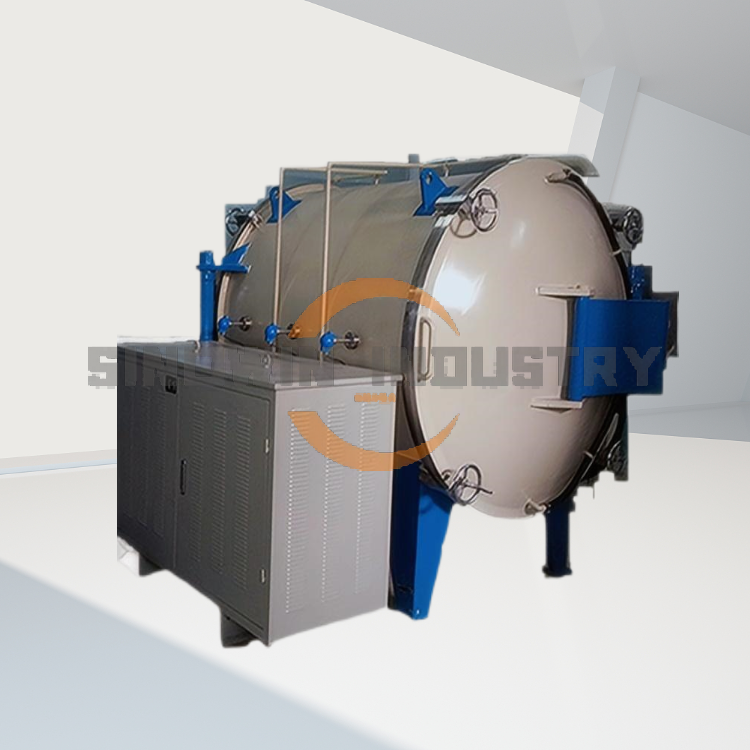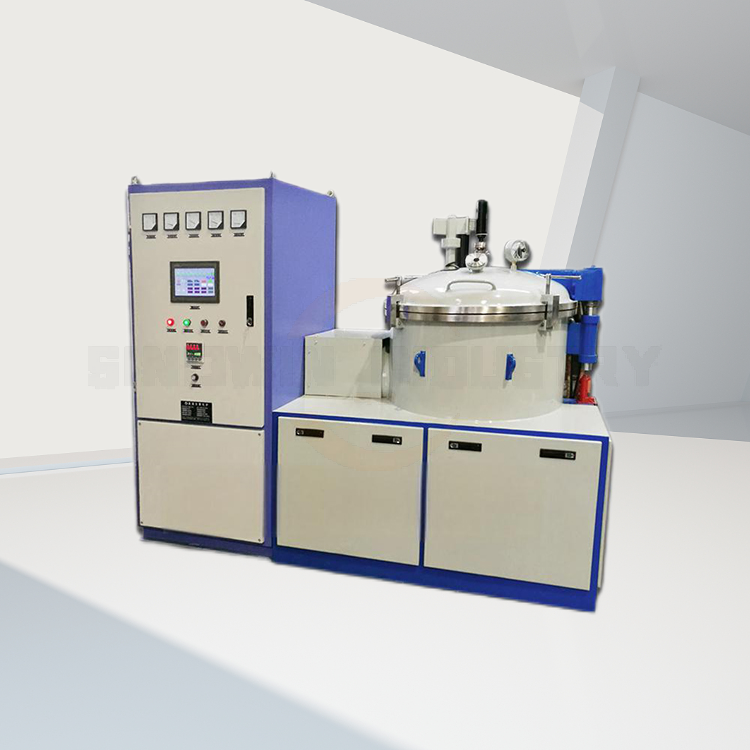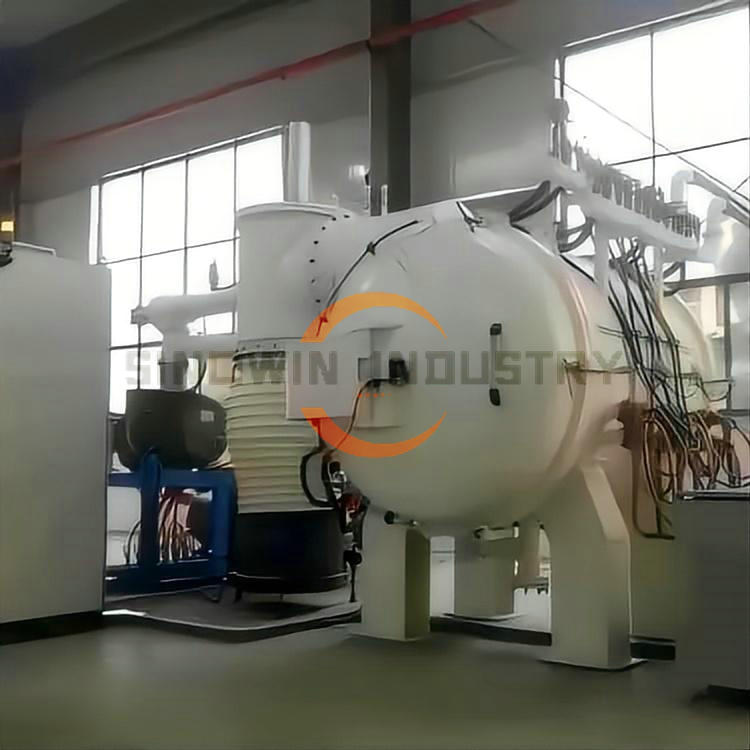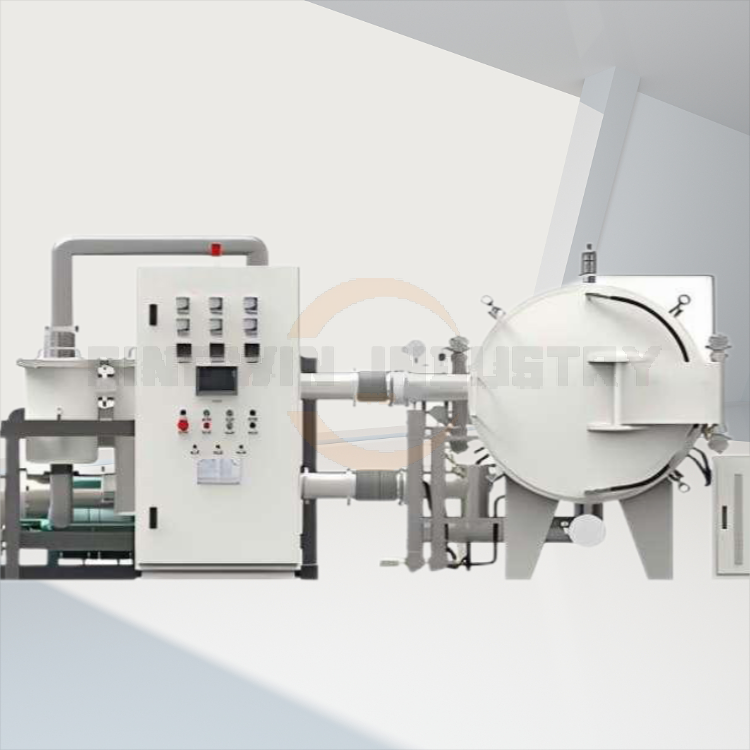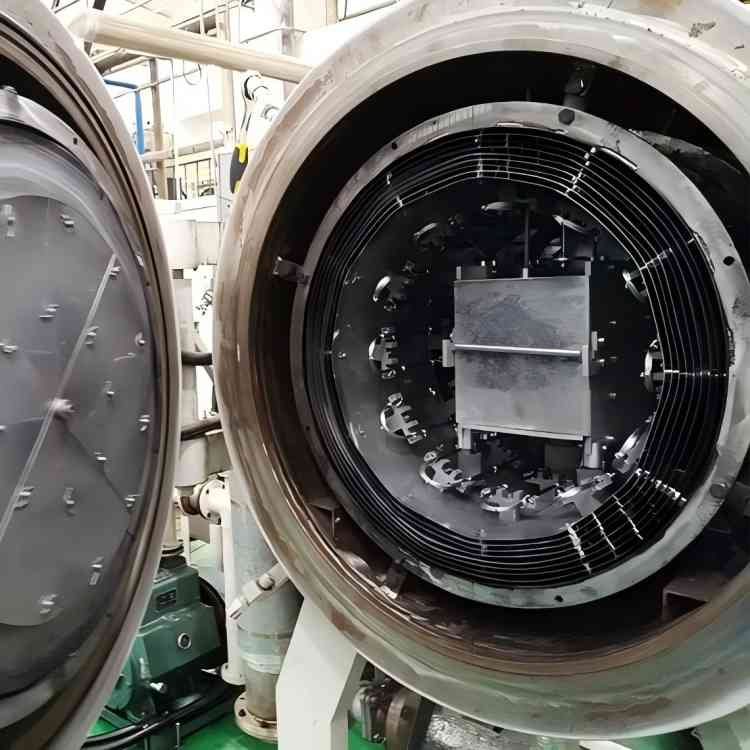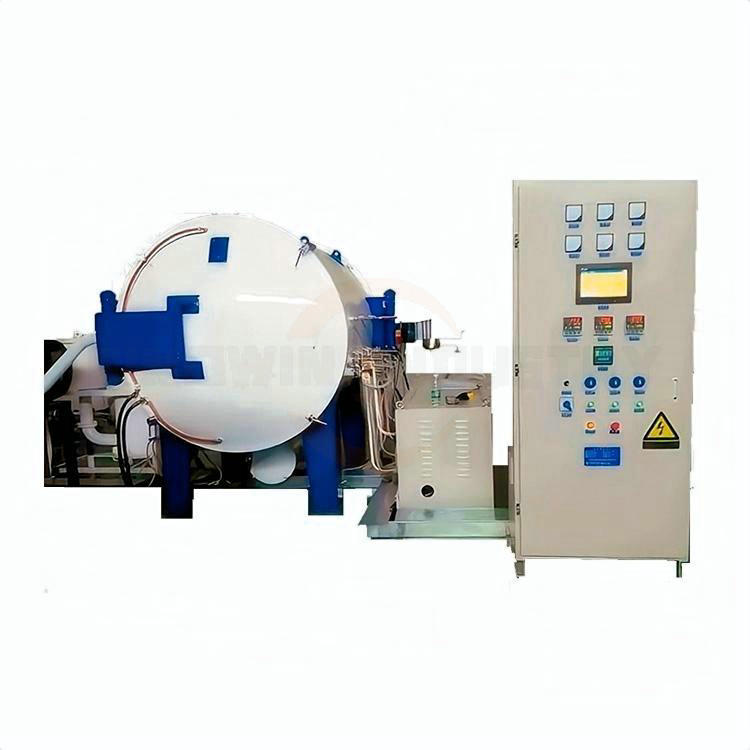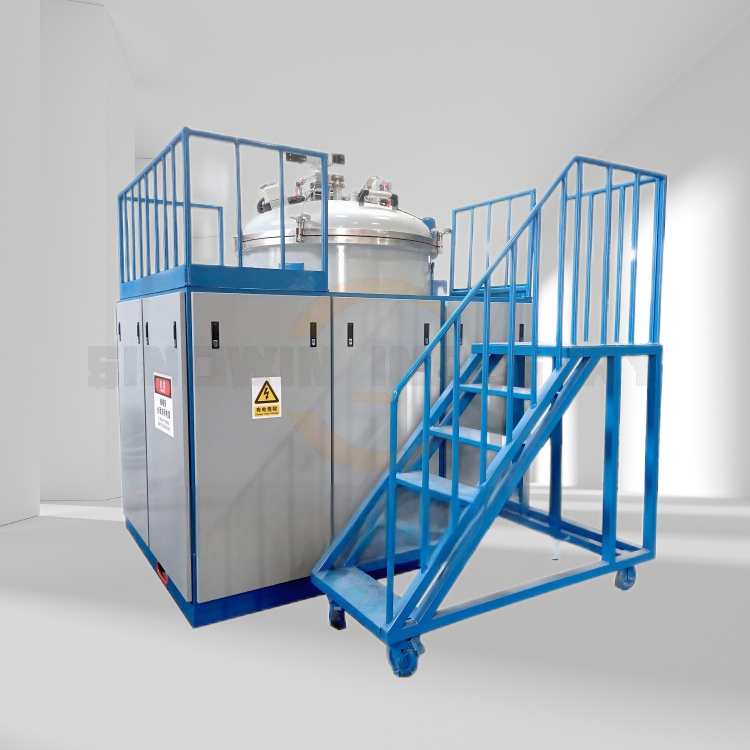Product Description: Battery Anode Material Graphitization Furnace
Battery Anode Material Graphitization Furnace, an advanced solution engineered for high-performance graphitization processes, is specifically designed to meet the rigorous demands of battery anode material production, ensuring efficiency, safety, and precision.
Key Features and Specifications:
- Furnace Structure:
- – The furnace is available in both vertical and horizontal configurations. It boasts a double-layer water-cooling structure, where the inner chamber is crafted from 304 stainless steel, featuring a cooling water passage for superior thermal management.
- – Capable of both vacuum extraction and protective gas operation, this furnace is equipped with gas inlet ports, an infrared temperature measurement hole, an exhaust port, and an adjustable base height to accommodate various induction sensor heights.
- Induction Sensor:
- – Constructed from high-quality square copper tubing with low magnetic leakage and high efficiency. The fixed support for the sensor is made from stainless steel, ensuring resistance to high-temperature carbonization.
- Resonance Capacitor:
- – The resonance capacitor employs a water cooling structure, deliberately leaving a 30% capacity margin for enhanced performance stability.
- Infrared Temperature Measurement:
- – Utilizes imported infrared thermometers for real-time monitoring of temperatures on the crucible. Our dual-color infrared thermometer assures precise measurements even in smoky, dusty environments.
- Vacuum System:
- – The vacuum system comprises a direct-coupled mechanical pump, a gas-charging electromagnetic valve, a vacuum butterfly valve, a diaphragm valve, and connecting pipelines. The system includes a diaphragm valve for gas charging and another for atmospheric reconstruction prior to opening the furnace door.
- Electrical Control System:
- – Features a 0.1% precision intelligent segmented program control unit, capable of storing up to 50 heating programs. Optional communication ports enhance connectivity, while PLC protection monitors phase loss, water pressure, circuit integrity, protective gas, vacuum pump, furnace temperature, and cabinet temperature. This system incorporates sequential control, interlocking protection, and alarm functionalities, with alerts for excessive water temperature exceeding 60°C and insufficient vacuum conditions.
Performance Characteristics:
- High Operating Temperature:
- – The furnace can operate at temperatures up to an impressive 3000°C, with a typical operational range of 2800°C, facilitating effective graphite purification.
- Sealed Structure:
- – With a fully sealed structure complemented by a vacuum extraction system and argon gas replacement system, the furnace ensures the purity of gases within the chamber.
- Energy Efficiency:
- – Utilizing electromagnetic induction heating techniques, this furnace directly heats the graphite container, leading to remarkable energy and cost savings.
- Rapid Heating Rates:
- – Achieves heating rates of up to 600°C per hour (even faster at lower temperatures).
- Precision Temperature Control:
- – Employs special infrared measurement technology and PID segmented program controls the heating curve, delivering high accuracy and minimal deviation in temperature management.
- Enhanced Safety:
- – Constructed with a double-layered stainless steel shell, the outer shell remains below 50°C, incorporating pressure, water pressure, and high-temperature alarms alongside an overpressure venting system for added safety.
- Optimized Furnace Design:
- – The cavity design takes advantage of international vacuum induction furnace concepts, combined with years of high-temperature furnace manufacturing experience from our company, Hunan Aipude. This results in improved insulation performance, temperature uniformity, reduced labor intensity, and domestically sourced refractory materials, significantly lowering production costs.
Parameter of The Battery Anode Material Graphitization Furnace:
| Work Size (mm) | Φ200×300 | Φ300×400 | Φ400×1000 | Φ500×1000 | Φ600×1000 | Φ600×1600 |
| Volume(L) | 9 | 28 | 125 | 196 | 282 | 452 |
| Heating Power | 100 KW | 160 KW | 200 KW | 250 KW | 300 KW | 350 KW |
| Frequency | 2000 Hz | 2000 Hz | 2000 Hz | 1500 Hz | 1500 Hz | 1500 Hz |
| Max. Work Temperature | 3000°C | |||||
| Ultra Vacuum | 1.2×10-3 mbar | |||||
| Optional High Vacuum | 5×10-5 mbar | |||||
| Max.temperature rise rate | 15°C/min (RT~1500°C), 10°C/min (1500°C~2500°C), 5°C/min (2500°C~3000°C) | |||||
| Vacuum Pressure | 6.7×10-3 mbar/hr | |||||
| Atmosphere | High Vacuum(optional)/ Vacuum/ Inert Gas(Ar or N2)
Vacuum and high vacuum atmospheres are only allowed below 2200°C |
|||||
| Power | 3P, 380V, 50Hz/60Hz | |||||
| Pressure of the cooling water | 1.5~2.5 bar | |||||
| Water of the cooling water | ≤28 °C | |||||
The Battery Anode Material Graphitization Furnace embodies the pinnacle of engineering excellence, ensuring that you achieve optimal results in your battery manufacturing processes. Whether you are in research, analysis, or manufacturing, the Graphene Graphitization Furnace supplied from SINOWIN INDUSTRY is your best choice.
Donot hesitate to Contact us today for a quote and transform your scientific journey completely
Product Q&A for Graphitization Furnace for Battery Anode Materials
Q1: What is the maximum operating temperature of the graphite furnace?
A: The maximum operating temperature of our battery negative electrode material graphite furnace can reach an impressive 3000°C, with optimal performance achieved at 2800°C. This high-temperature capability enables a thorough graphite purification process, ensuring superior quality and efficiency in your production.
Q2: How does the sealing system of the furnace enhance its performance?
A: Our furnace features a fully sealed structure, complete with a vacuum pumping system and argon gas replacement. This design guarantees the purity of the gases inside the furnace, protecting your materials from contamination, which is crucial for high-quality graphite production.
Q3: What energy-saving features does this furnace provide?
A: The furnace utilizes electromagnetic induction heating, which directly heats the graphite crucible, resulting in high thermal efficiency and significant energy savings. This innovative heating method not only minimizes energy consumption but also enhances overall productivity.
Q4: Can you explain the temperature ramp-up rate of the furnace?
A: Our furnace boasts an impressive heating rate of up to 600°C/hour, with even faster rates achievable at lower temperatures. This rapid heating capability is designed to optimize your operational efficiency and minimize waiting times during production cycles.
Q5: How accurate is the temperature control in this furnace?
A: The furnace employs advanced infrared temperature measurement technology alongside PID segmented program control for the heating curve. This results in highly precise temperature management, with minimal deviation, allowing you to maintain exact conditions necessary for optimal graphite processing.
Q6: What safety features are included in this furnace design?
A: Safety is paramount with our furnace design, which includes a double-layer stainless steel casing with water cooling between layers, ensuring the outer shell remains below 50°C. Additionally, there are built-in pressure, water pressure, and high-temperature alarms, along with a pressure relief device, ensuring safe operation at all times.
Q7: How does the furnace’s design compare to international standards?
A: The design of our furnace takes significant inspiration from advanced foreign vacuum induction furnace concepts. This ensures that our furnace meets high international standards in performance and reliability, making it an excellent choice for your graphite purification needs.
Parameter of The 3000°C Battery Anode Material Graphitization Furnace:
| Work Size (mm) | Φ200×300 | Φ300×400 | Φ400×1000 | Φ500×1000 | Φ600×1000 | Φ600×1600 |
| Volume(L) | 9 | 28 | 125 | 196 | 282 | 452 |
| Heating Power | 100 KW | 160 KW | 200 KW | 250 KW | 300 KW | 350 KW |
| Frequency | 2000 Hz | 2000 Hz | 2000 Hz | 1500 Hz | 1500 Hz | 1500 Hz |
| Max. Work Temperature | 3000°C | |||||
| Ultra Vacuum | 1.2×10-3 mbar | |||||
| Optional High Vacuum | 5×10-5 mbar | |||||
| Max.temperature rise rate | 15°C/min (RT~1500°C), 10°C/min (1500°C~2500°C), 5°C/min (2500°C~3000°C) | |||||
| Vacuum Pressure | 6.7×10-3 mbar/hr | |||||
| Atmosphere | High Vacuum(optional)/ Vacuum/ Inert Gas(Ar or N2)
Vacuum and high vacuum atmospheres are only allowed below 2200°C |
|||||
| Power | 3P, 380V, 50Hz/60Hz | |||||
| Pressure of the cooling water | 1.5~2.5 bar | |||||
| Water of the cooling water | ≤28 °C | |||||
